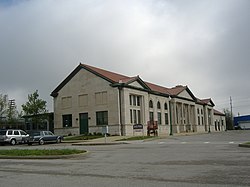Historic Railpark and Train Museum
|
Louisville and Nashville Railroad Station
|
|

The historic Louisville and Nashville
railroad station in 2008 |
|
| Location | Bowling Green, Kentucky |
|---|---|
| Coordinates | 37°0′0″N 86°26′17″W / 37.00000°N 86.43806°WCoordinates: 37°0′0″N 86°26′17″W / 37.00000°N 86.43806°W |
| Built | 1925 |
| Architect | Unknown |
| Architectural style | Late 19th And 20th Century Colonial Revival, Other |
| MPS | Warren County MRA |
| NRHP Reference # | 79003519 |
| Added to NRHP | December 18, 1979 |
The Historic Railpark and Train Museum, formerly the Louisville and Nashville Railroad Station in Bowling Green, Kentucky, is located in the historic railroad station. The building was placed on the National Register of Historic Places on December 18, 1979. Opened in 1925, the standing depot is the third Louisville & Nashville Railroad depot that served Bowling Green.
The first Bowling Green railroad depot was built in 1858 prior to the L&N's rails reaching Bowling Green. The rail line from Nashville reached Bowling Green on August 10, 1859. The line between Louisville and Nashville was complete on October 18, 1859, and was celebrated by 10,000 Nashvillians.
During the Civil War, the young L&N found itself to be a point of contention between the North and South. Kentucky was integral to the war and President Lincoln summed up the situation in this manner: "I think to lose Kentucky is nearly the same as to lose the whole game". Bowling Green was critical to both sides with its proximity to the Confederate state of Tennessee. The L&N branched just south of Bowling Green with routes to Clarksville, TN, and the line to Memphis, TN, opening the path to the Western war plans. By 1863 the L&N was the only railroad to cross both Union and Confederate Territories. The actions of L&N President James Gutherie resulted in a contentious relationship with the U.S. War Department, after the Battle of Perryville sealed Kentucky's alliance, but saved the L&N's future.
When the Confederates were forced to retreat from the city in February 1862, they burned downtown and all the supplies they could not carry, as well as the depot and trains. The Union troops occupying the city set about building a new depot. It was a wooden building and served the railroad and people of Bowling Green into the 20th century.
In 1878 malaria broke out from New Orleans to Memphis, Tennessee. Residents of Memphis wishing to escape the epidemic boarded the L&N trains, but residents from other towns refused to let them leave the train at their towns. Bowling Green's station was the first place they could leave the train, but enormous bonfires were built in order to deter infection. The evacuation of Memphis lasted a few days, until Memphis was quarantined.
...
Wikipedia


